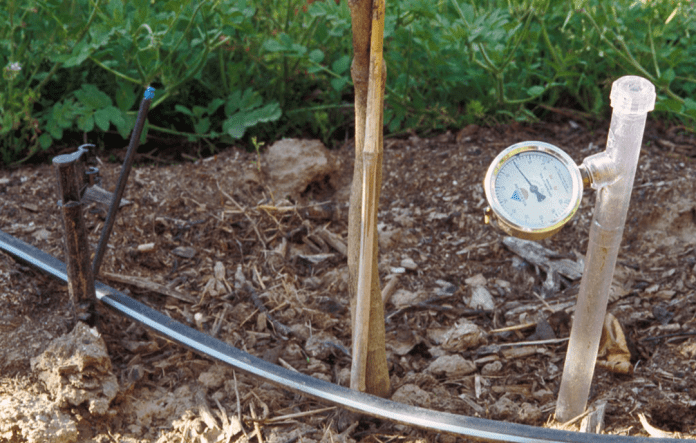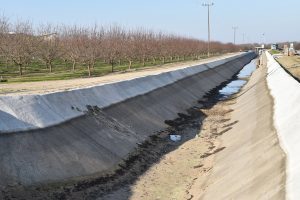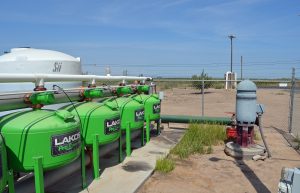
As the state heads into what could be a fourth year of drought, many growers have already developed irrigation plans based on worst-case and best-case scenarios. Ultimately, irrigation strategies will hinge on tree age, water allocations and production goals, whether growers can hope to make a crop or simply keep trees alive, said Curt Pierce, a UCCE area irrigation and water resources advisor for Glenn, Tehama, Colusa and Shasta counties.
And in some areas that have had perennial water cutbacks, growers are deciding whether to even keep orchards.
“These are the hard decisions they’re having to make,” Pierce said.
For growers with orchards, he recommended off-season maintenance of irrigation systems to ensure they’re ready to run at peak efficiency come spring.
“When I’m going out on farm calls, I’m seeing a lot of maintenance issues,” Pierce said. “If you’re having iron sludge in the system or sand in your system, it doesn’t matter what you’re planning for your deficit irrigation, the water isn’t going where you think it’s going.”
Mobile Irrigation Testing
To aid growers, mobile irrigation laboratories perform irrigation system evaluations and offer tips and recommendations free of charge or at a low cost.
The North West Kern Resource Conservation District, for example, has had a mobile lab serving growers from Kern County north to Madera County for 35 years. But recent state Water Efficiency Technical Assistance grants have allowed some RCDs elsewhere to start offering similar services.
“This year (2022) was the third-busiest,” said North West Kern RCD Manager Brian Hockett, who has been conducting irrigation audits for 35 years. “The year before it was the highest year in 35 years of doing testing. I average 150 to 160 (visits) a year. In 2021, it was 227, and in 2022, it was 188, so it’s above normal and it starts out as early as January and runs through the summer.”
He’s already had growers calling to make appointments for system testing after the winter holidays. For persons interested in the service, Hockett said it’s better to call sooner rather than later because he expects to be in high demand once again this season.
Having a system evaluated annually isn’t necessary, and he said once every two years typically is fine. But Hockett said he has one client who has his system checked every year.
“He uses that as an incentive for his irrigators to do a good job,” Hockett said. “He gives them a bonus if they’re above 90% DU (distribution uniformity).”
Most evaluations run between 85% and 90% distribution uniformity, indicating growers are keeping up their systems. But a few are significantly lower than that.
“When water costs $250 up to $1,000 to $1,500 (per acre-foot), you can’t put it out there willy-nilly. And in some areas, that $1,500 is low,” Hockett said. “You want to make sure you’re doing as efficient a job as possible.”
How to Divide Reduced Water Deliveries
Pierce said ultimately, irrigation regimes depend on the amount of available water. UC research conducted by Mario Viveros and David Goldhamer in the 1990s and Ken Shackel in the early 2000s found mature almond trees can survive on as little as 8 inches of water annually. But canopy growth and nut production decreased significantly under severe water restrictions.
The subsequent year’s crop also may be affected since bud development occurs during the previous mid-summer. In addition, the effects can be cumulative with continued deficit irrigation.
“Almonds are a drought-resistant crop,” Pierce said. “They’re rain-fed in other parts of the world. In California, we support them with irrigation because we’re looking to maximize yields.”
If irrigation deliveries are reduced 40% or less, Pierce said growers should focus on the applications in the period right before and after hull split. His recommendations are based on mature orchards.
“If you’re over 60% [irrigation allocation], I’d feel more confident trying to bias the deficits around hull split,” Pierce said.
Applying full irrigations through early June, depending on the orchard location and variety, will aid shoot growth and kernel fill, while deficit irrigations from mid-June through July can aid in hull split. That’s as long as irrigations are resumed about two weeks before hull split at their location. An irrigation after hull split should help reduce stick-tights and help with shaking. He encouraged growers to save some water for a postharvest irrigation to set the tree up for next season.
Gauging Tree Water Status
Pierce recommended using soil moisture monitoring technology such as tensiometers to gauge soil moisture levels. But soil moisture is only part of the story and doesn’t necessarily reflect the water status of the tree. For that, he encouraged growers use pressure bombs, also known as pressure chambers.
Although the technology is viewed by some as labor-intensive, Pierce said that growers can reduce labor requirements by dividing an orchard into zones based on soil water-holding capacity. Then they only need to sample one representative tree within each zone.
If growers expect to receive significantly reduced water deliveries, Pierce recommended a simple approach of spreading applications out evenly during the growing season.
“With situations where you’re only able to irrigate to less than 30% or 40% of ET (evapotranspiration), you’re not really so much supporting the crop as dealing with almond tree survival. Even when more water is available, evenly applying any irrigation deficits throughout the season might be the best approach for most situations,” he said.
For walnuts, Pierce said the best way to maximize irrigations is to delay the first spring water application until pressure bomb readings are 2 bars below baseline. “This is really the best way to realize some water savings for walnuts,” he said. “This could get you through, or deep into May without having to irrigate.”
While walnut irrigations can be withheld through the early season with little negative or even some positive effects, water reductions after the May and early June period may cause quality issues for the current season’s crop. It also will likely lead to reduced bud development and crop in the subsequent year.
Some Tough Decisions
Fresno-based Woolf Farming has almond orchards from Kern to Stanislaus counties and in Glenn County, said Daniel Hartwig, Woolf Farming resource manager. As a result, they have varying surface supplies, depending on the local irrigation provider’s contracts and water rights. Groundwater supplies and quality also vary with location.
Outside of orchards in the Westlands Water District west of Fresno, most of the trees are young at 5 to 7 years old. Even under deficit irrigation, he said younger tree production tends to bounce back once full irrigation is resumed.
But Westlands is a different story. The district received zero federal water allocations in 2022 and 2021 and only 20% in 2020. The last year the district received full deliveries was 2017.

In addition, groundwater depths and quality have continued to decline. If surface water was available for sale, Hartwig said it was prohibitively expensive.
Anticipating a fourth year of drought, he said the family farming operation plans to pull “a pretty good chunk of acreage” of older almond trees within Westlands.
“We know those yields aren’t coming back, at least in the foreseeable future,” Hartwig said. “With the trees being so old, they might not come back at all.”
He said they also factored in lower almond prices and Sustainable Groundwater Management Act implementation that will start in 2023 within Westlands.
To stretch water supplies and maximize water-use efficiency, Hartwig said they use several technologies, including tensiometers, pressure bombs and satellite imagery.
All of their orchards are on double-line drip irrigation, and they perform system distribution uniformity tests at least once annually. They also conduct pump tests multiple times a year, starting at the beginning of the season and finishing with season’s end.
“It’s our most important resource and our most limited resource,” Hartwig said.
Woolf’s pistachio orchards are in Fresno and Madera counties, with orchards ranging in age from 7 to 12 years to some with trees as old as 25 years. But production within the older pistachio trees appears more resilient to drought conditions than older almond trees.
“Pistachio production really doesn’t seem to drop off when you get out to those older trees,” he said of deficit irrigation regimes. “They seem to be a lot more salt-tolerant than almonds. We haven’t really made those tough decisions, and prices have been more stable.”


Vicky Boyd | Contributing Writer
A veteran agricultural journalist, Vicky Boyd has covered the industry in California, Florida, Texas, Colorado, the South and the Mid-South. Along the way, she has won several writing awards. Boyd attended Colorado State University, where she earned a technical journalism degree with minors in agriculture and natural resources. Boyd is known for taking complex technical or scientific material and translating it so readers can use it on their farms. Her favorite topics are entomology, weeds and new technology. When she’s not out “playing in the dirt,” as she calls agricultural reporting, Boyd enjoys running, hiking, knitting and sewing.















